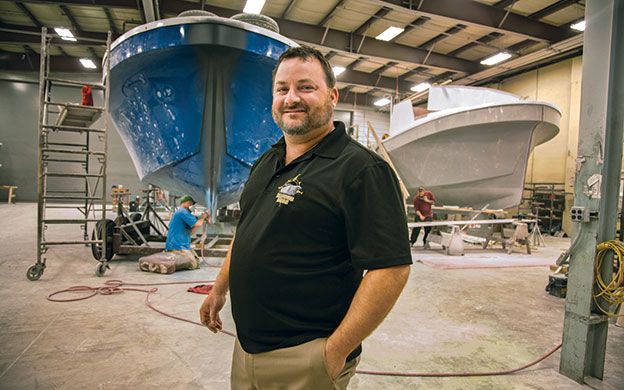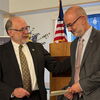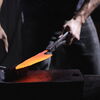A boon for boat builder: Millennium Marine grows jobs in Eastport
The boatbuilding firm Millennium Marine has had mostly success since it moved from New Brunswick to Eastport a year ago — so much so, that it plans to add 20 employees.
Millennium Marine manufactures specialized vessels for fishermen, government agencies, research organizations and other professional operations. The third-generation family business has produced more than 600 boats over seven decades. It produces fiberglass boats in the 25- to 50-foot range, under the names Miramichi, Millennium and Donelle.
In recent months, the firm has been splashing the first boats completed at its new site in Eastport, with more popping out of the molds and others in the process of being laid up. The launch season began in early March, with a Millennium hull just under 50 feet long destined for Ilwaco, Wash., to fish for Dungeness crab, capable of packing nearly 20,000 pounds in the fish holds. Others launched this spring are headed to New Brunswick, Nova Scotia, Virginia, the West Coast, St. Thomas in the U.S. Virgin Islands and elsewhere in Maine.
A surge in orders is expected to keep the boat builder busy into 2016. Owner Cory Guimond expects to expand the staff from 30 to about 50.
“We're in demand. We need many more skilled workers,” says Guimond, who provides on-the-job training. Workers skilled in fiberglass boatbuilding are hard to come by in Eastport, he says.
“The city council and I couldn't be happier to have Millennium Marine here, putting people to work in the maritime industry, which is very important to Eastport's past and to its future,” says City Manager Elaine Abbott. “It's exciting for people here to be trained on the job for a viable skill that they can use along any coastline. Many people have to string together multiple jobs, so it's also great to have year-round jobs with Millennium Marine.”
Millennium got its start in the 1940s, when Guimond's grandfather, Philias Guimond, built wooden fishing boats under the name Guimond Boatyard. He was based in the fishing village of Escuminac, N.B., 285 miles northeast of Eastport. Guimond's father, also named Philias, but called Phil, took over the business and transitioned into fiberglass in 1981, building boats mainly for fishermen throughout Atlantic Canada. There was plenty of demand, says Cory Guimond, who was born and raised in Escuminac. “There were fleets of thousands of boats that needed to be converted from wood to fiberglass,” he says.
But as more builders came into play, the market for Guimond boats slowed. At the same time, Phil developed health problems he believed to be a reaction to the resins used in fiberglass boatbuilding. He stopped building in 1991, then started again in wooden boats, with Cory, in 1994. Phil died in 1995. Cory completed a handful of wooden boat commissions over the next year or two.
“I love building wooden boats,” Cory Guimond says. “There's no demand for it anymore. But in the 1990s, there was enough demand.”
In 1997, Cory Guimond pulled a mold off one of his wooden boats and the company went back into fiberglass work. He also began heavily marketing his work, pressing into the U.S. market, expanding his outreach beyond fishermen to government and research entities and other types of professional operations, such as tour and dive boats, and gaining a number of commissions not only along the Atlantic seaboard but on the West Coast and Alaska and Hawaii.
“We attended trade shows. We made a lot of promotional videos, running the boats in rough weather. My boats do very well in rough weather,” he says. “When I first started with video, they were on VHS cassettes. I'd make hundreds of cassettes and take them to trade shows. Today it's uploaded on our website or on YouTube.”
By the start of the new millennium, Guimond's plant consisted of several buildings totaling 18,000 square feet. In 2002, the facility was destroyed by fire. Guimond bought two adjoining buildings, totaling 9,000 square feet, in the nearby city of Miramichi, where his crew rebuilt the boat molds while the Escuminac plant was rebuilt.
“It was a temporary fix,” he says. “But after the molds were completed, there was such a demand that we were able to occupy both facilities.”
Guimond moved away from the family name to Millennium around, well, the turn of the millennium.
“It was a marketing strategy,” he says. “The Guimond name isn't known in other parts of the world, whereas 'Millennium' is catchy and memorable. Our Millennium designs are now our main product.” In 2010, he expanded his lineup with the purchase of the 43-foot and 35-foot molds from New Brunswick-based Donelle Boat Yard, now defunct. At its peak, Millennium Marine produced about 20 boats a year, with around 30 employees.
From 2007-09, demand for boats plummeted and Guimond downsized his staff to 10. As the recession eased, work picked up. Guimond began to think about moving his operation to the United States. There were many upsides. The states represented about 75% of Millennium's market for fishing boats. There was potential for expansion into passenger and cargo boats, which were otherwise restricted by the Jones Act, which prohibits foreign-built vessels from engaging in coastal trade in U.S. waters.
Guimond searched as far as the Carolinas for the move, but settled on Eastport, one of three deep-water ports in Maine. Unlike northern New Brunswick, Eastport's extreme tides and slightly warmer weather prevent the harbor from icing over in the winter, making those months available for boat launches. Most importantly, the city was eager to have a tenant to make use of a grant awarded to renovate a historic mill building for industrial use. The U.S. Economic Development Administration originally awarded the $1.42 million to Washington County and the city of Eastport to renovate the 60,000-square foot Guilford Mill for use as a marine renewable energy manufacturing facility, which was expected to create dozens of jobs. That deal fell through. Guimond picked up on the opportunity, invested an additional $75,000 and retrofitted about half of the space for boat production.
“The city now has a building that is designed for a range of boatbuilding and they lease it to me,” says Guimond. “So it was a win-win situation for everybody.”
In May 2014, the city received $100,000 under the Community Development Block Grant program for Millennium to train 12 employees.
In July, three months after moving in, the plant suffered a fire. At the time, there were two boats under construction, both slated for West Coast fishermen. There were 14 people on the payroll. The fire destroyed both boats and caused smoke damage. A sprinkler system saved the building. The fire apparently started in a trash barrel.
The crew was back in the building the next day, removing debris and scrubbing soot. The firm lost the contract for one of the boats, but rebuilt the other, and has been expanding ever since.
Millennium Marine designs are a modified hybrid of the traditional fishing boats of the Northumberland Strait and the “Novi” boats of Nova Scotia. Characterized by a flared, rounded bow, high forward sheer, raked shelter and deep draft, the boats are known for their great stability in rough seas, high carrying capacity and the strength of their solid fiberglass hulls balanced by weight-savings in the cored superstructures, says Guimond.
Today, Guimond looks forward to getting new workers trained and pushing production beyond 2016.
“When I started here this time last year, only one of my employees had any experience in a boatyard,” he says. “The rest have been trained in-house. Now it's going quite well on its own, although I do spend a lot of time on the shop floor. It's been 'train the trainer.' They learn how to operate the equipment, cut the material, wet it, roll it out, spray it, and then they pass it on to the next employee. A lot of the core workers who started here are still with us today. We're grateful for that.”
Read more












Comments